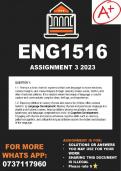, QUESTION 1:
1.1. Poetry is a form of artistic expression that uses language to evoke emotions, convey
thoughts, and create imagery through carefully chosen words, rhythm, and often structured
patterns. It's a medium where the beauty of language is used to capture and communicate
complex ideas, feelings, and experiences.
1.2. Exposing children to nursery rhymes and poems for children offers several benefits: a)
Language Development: Nursery rhymes and poems use language in a playful and
rhythmic manner, helping children develop vocabulary, phonemic awareness, and
language comprehension skills. b) Cognitive Development: Engaging with rhymes and
poems enhances cognitive skills such as memory, pattern recognition, and critical thinking
as children explore the rhythm and structure of the language.
QUESTION 2:
2.1. The nursery rhyme "Five Currant Buns" is an example of a counting rhyme. It follows
a repetitive structure and rhythm that helps children learn and remember numbers in a fun
and engaging way. The repeated lines with variations encourage participation and
anticipation, making it suitable for young children.
2.2. Three guidelines for selecting poems for Foundation Phase learners are: a)
Appropriate Content: Choose poems that are age-appropriate and relevant to children's
experiences and interests. b) Engaging Language: Select poems with vivid imagery,
rhythmic patterns, and playful language to capture children's attention and foster their
imagination. c) Cultural Sensitivity: Ensure that the chosen poems are respectful of
diverse cultures and backgrounds, promoting inclusivity and understanding among
students.
2.3. "Five Currant Buns" would be an appropriate poem for a Foundation Phase
classroom. Its repetitive structure and counting theme align with young children's learning
needs, helping them grasp numerical concepts in an enjoyable way. The rhyme's simple
language and engaging narrative make it suitable for early readers, while its playful tone
encourages participation and active learning.
2.4. To bring "Five Currant Buns" to life in a Foundation Phase classroom: Introduce the
rhyme through a lively and animated reading, using expressive voices and gestures. Use
visual aids like large cut-out currant buns to help children visualize the counting process.
Encourage students to take on roles, assigning some as buns, others as the boy/girl, and
act out the rhyme. Incorporate hands-on activities like a pretend bakery, where students
can "buy" and "sell" currant buns using play money. Extend learning by discussing the
concept of buying, selling, and counting money, fostering both language and math skills in
an integrated manner.
QUESTION 3:
Reading plays a crucial role in the development of Foundation Phase learners. It serves as
a fundamental tool for various aspects of their growth, including language acquisition,




